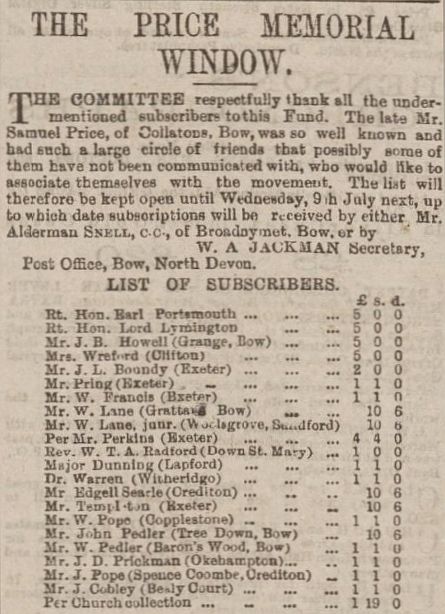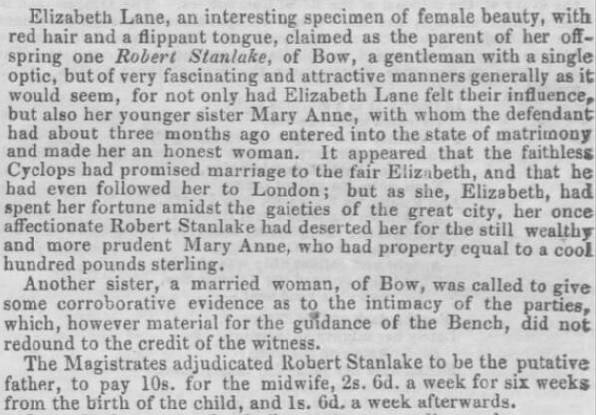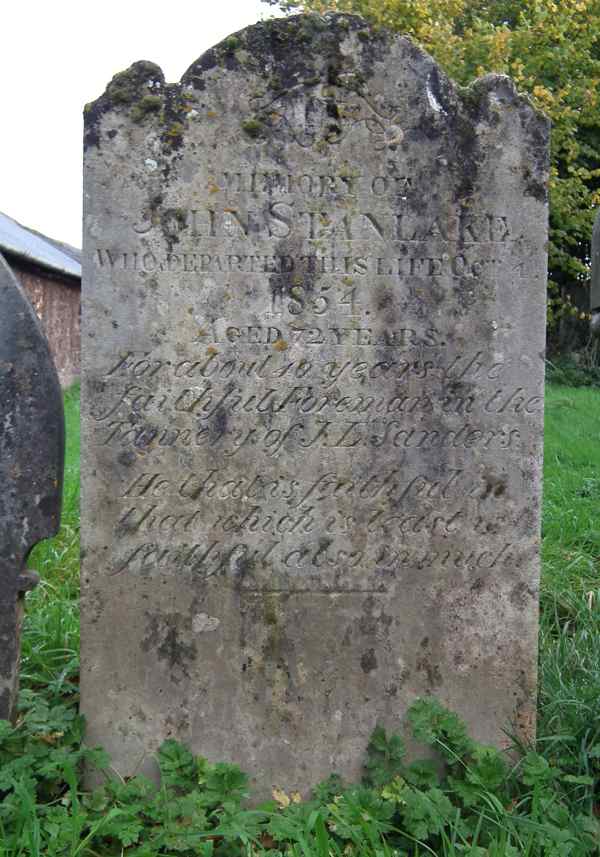
View from the South of (left to right): the Site of the Tannery, Collatons and Grattons just outside Bow
It is unclear when and where the tanning business started in Bow, but it was to become the most important industry in the village.
One of the earliest recorded Bow tanners was William Zeager, a church warden, whose children Mary and William were baptised in Bow Church in 1704 and 1706. A Robert Crispin was his apprentice in 1730.
There is a bit more information about Samuel Down. He married Thomazin Packer in Lapford in 1743 and is recorded as being a tanner in Bow, having as apprentices Robert Northcott, Simon Pope in 1767, George Packer in 1771, Samuel Bowden in 1772 and John Moore at the time of Down’s death in Bow in 1782. In 1779 George Packer (born Lapford 1759) married Samuel Down’s daughter Elizabeth (who was probably George's cousin) and later took over the running of the tannery.
George Packer’s son William (1784 - 1856) later joined him in the business, and took over after his father’s death in 1834. William Packer left £400 in his will to provide a water supply to Bow Village.
Samuel Wreford was born in Zeal Monachorum 1783, son of Samuel and Mary (née Sweet). (The Sweet family was also involved in the tannery business in North Tawton and elsewhere.) Samuel Wreford Junior set up as a tanner in Bow after his marriage in 1804. A successful businessman, he built Grattons, where he later operated a small but successful horse stud.
A few years later James Lee Sanders, previously a tanner in St Thomas, Exeter, moved to Bow. He lived in Collatons, which is on the opposite side of the road from Grattons, but right next door to the tannery. Both Grattons and Collatons are shown on an 1816 plan, although neither of them appear on a draft Ordnance Survey map of the village from 1804.
James Lee Sanders was born in Salcombe Regis in 1786. He married Maria Langdon in 1813 and they had four children.
In 1839, there appeared to be two separate tanning operations in Bow: William Packer, and James Lee Sanders and his brother John.
Maria Sanders died at her son-in-law’s house in Exeter in 1844. Ten years later her husband erected a memorial window to her in Bow Church. Their son James (1814-1878) had started off in the tanning trade but then became a merchant “in hide and valonia” in Exeter. Valonia was the name given to the cups of acorns of a species of oak, imported by ship from Turkey, and ground up for use in the tanning process. James’s daughter Maria Caroline “Minnie” married William Osmond Ward who later ran a large tannery in Tavistock.
Samuel Wreford died a relatively poor man aged 76 in 1859. James Lee Sanders then moved from Collatons to Grattons. He remarried when aged 63 to Mary Bennett (née Worthy), whose first husband had been Commandant of Ascension Island where he died in 1841. (Their son was later to marry her new husband’s youngest daughter.) Sanders spent the rest of his days at Grattons where he died in 1874.
When Sanders moved out of Collatons, Samuel Price (b 1827) moved in and ran the tannery until his death. Price’s parents farmed at East Worlington. He was married to Priscilla Milford Norrish, from Sandford. Their only daughter, Minnie, was born at Collatons in 1860.
In the Bermondsey, London, censuses between 1851 and 1871, over 40 leather workers are shown with a birthplace of Bow in Devon. From about 1847 until 1870 there had been considerable migration of men and their families from Bow and nearby villages to work in the Leather Market in Bermondsey.
In 1883, Exeter solicitor John Pope married Minnie Price, in what was probably the most extravagant wedding Bow has ever seen. The whole village was decorated for the event.
After the service at Bow Church there was a reception at Collatons. The wedding breakfast comprised: Salmon a la Mayonnaise, turkey Reine, roulard of veal en aspic, raised pie, chicken a la bechamel, galantine spiced beef, signet of lamb forced, chicken au cresses, tongue cornucopia, fillets of soles en aspic, lobster salad, Italian salad, meringue Montmorencie, gateau de Savoie orne, gateau Neapolitain, mosaic jelly, raspberry cream, vanilla cream, lemon jelly, macedoine jelly, Italian cream, Charlotte a la Russe, blancmange, faunchonettes, caprice, Swiss tartlets, rout cakes, maids of honor, biscuit glace ; ices—strawberry cream, raspberry and currant water, wafers, fruit.
Afterwards 400 children of the village were entertained to tea, followed by a fireworks display.
There were 14 cottages attached to Collatons estate and between 1851 and 1881 there were about 20 tannery workers living in “Halse Village”, as the collection of cottages was called.

Samuel Price became famous as a breeder of championship winning pointer dogs, some of which were exported to USA. He lived at Collatons until his sudden death on 31 August 1887. The funeral service took place in Bow, although he was buried at East Worlington. In 1890 funds were raised to pay for a new East Window at Bow Church as a memorial to him.
The tannery closed after Price died and all the machinery was sold off in 1889. Most of the tannery buildings were demolished in 1897.
The Pope family sold Collatons and the remaining tannery cottages and out-buildings in 1919.
Bow Church contains memorials to several people connected with tanneries: William Packer, Samuel Wreford, James Lee Sanders and his first wife Maria, as well as Samuel Price.
John Stanlake (1782-1854)
When, in about 1820, James Lee Sanders moved from Alphington to Bow, he brought his foreman John Stanlake with him. He was to be his tannery foreman for 40 years. Born in Bristol, he joined the Navy as an able bodied seaman, serving on HMS Canopus in the 1806 Battle of San Domingo against the French. He then became a Greenwich Pensioner, before coming to Devon.
John Stanlake's gravestone in Bow Churchyard, probably paid for by James Lee Sanders. Click on image to see the epitaph enlarged.
For about 40 years the
faithful Foreman in the
Tannery of J.L. Sanders.
He that is faithful in that which is least is
faithful also in much.

John Stanlake's only son, Robert Hearn Stanlake (1821-1893) was also a tanner. He worked in Herefordshire and Bermondsey. This rather unflattering account of him is taken from the Exeter and Plymouth Gazette in October 1847, three months after his marriage to Mary Anne Lane.
Elizabeth Lane (born in Exeter 1824) later had four children with widower William Heard (born in Bow in 1811).
John Stanlake's daughter Emma married George Sutton from Dunsford. He also moved to Bermondsey where he worked as a tanner.
by Peter Selley

